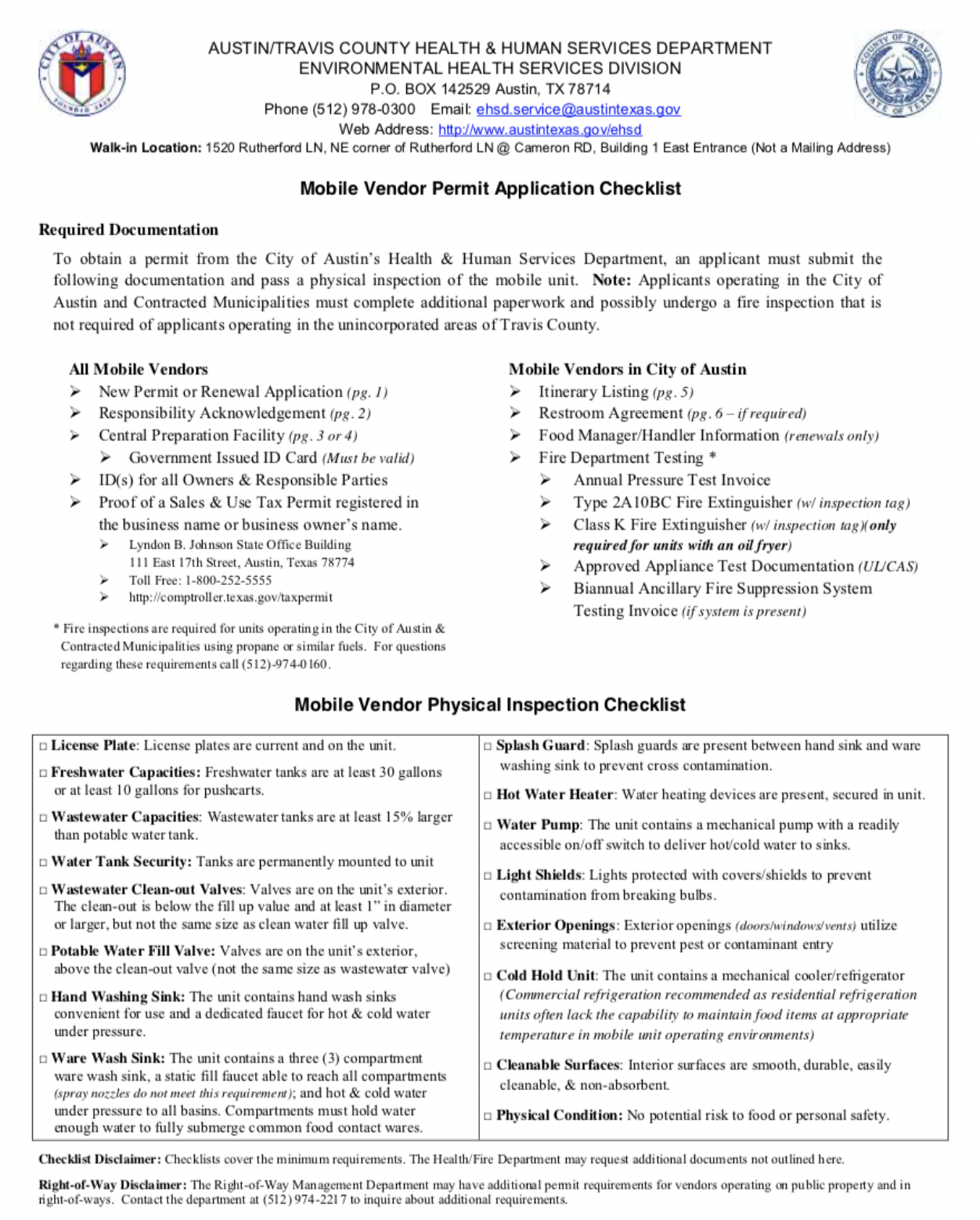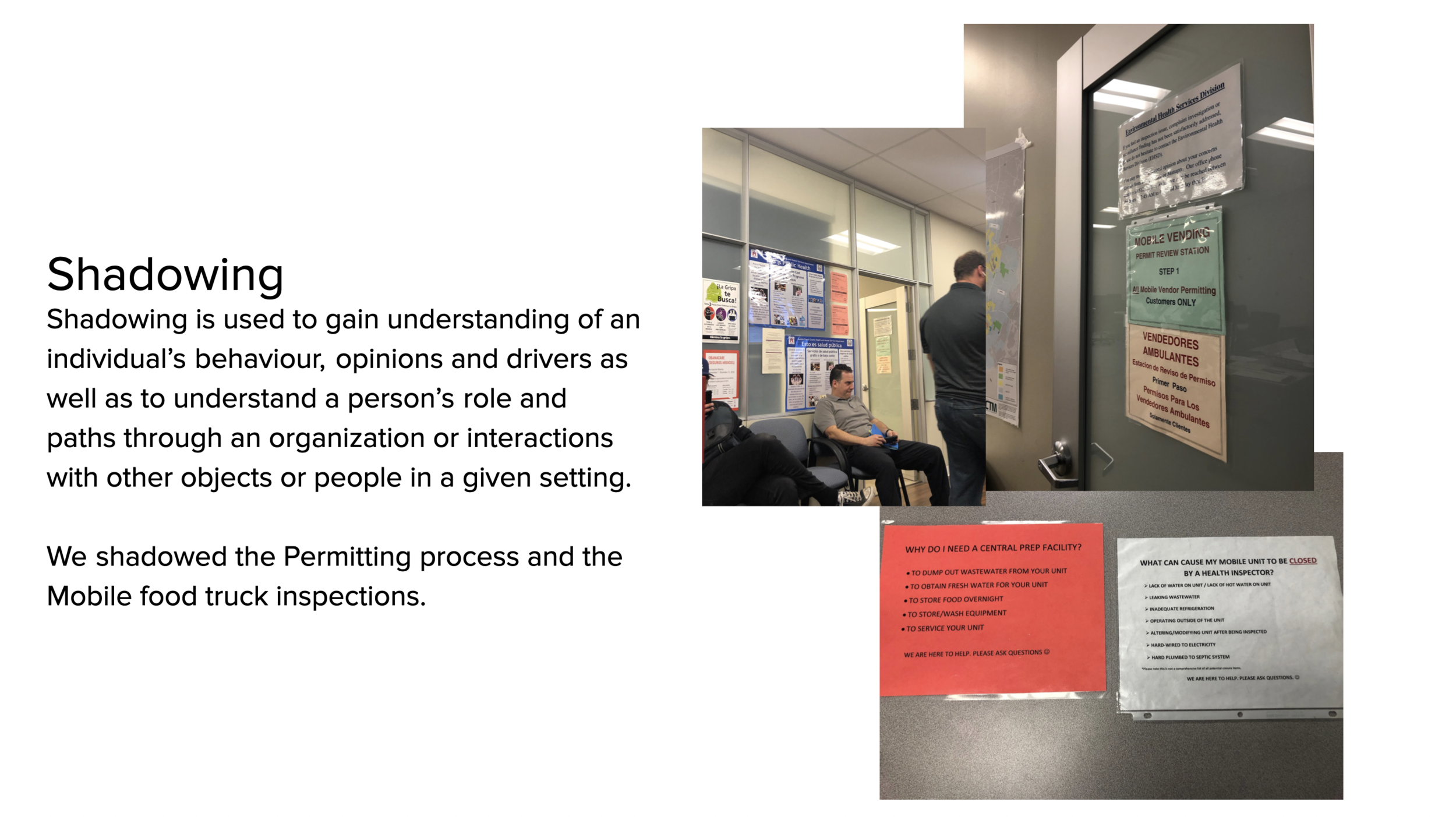Our office, in collaboration with the City of Austin’s, Public Health (APH), worked to understand the current pain points and obstacles that residents and providers during the food truck permitting process. This initiative is a partnership between neighborhoods, the community, government, public safety, researchers, and stakeholder groups. Together we worked to develop innovative ways to deliver in food truck services to residents equitably and efficiently, rather than short-term fixes, because these solutions must be sustainable over time.
Partner(s): Service Design Lab / APH: Austin Public Health APH / Food Truck owners/employees/ EHSD: Environmental Health Services Division / EHO: Environmental Health Officer / CPF: Central Preparation Facility
Duration: 6 Weeks
My Role: (Design & Research) Interviews (foundational/usability), Workshop Creation & Facilitation, Synthesis & Ideation of data
Design: Service Blueprint, Interactive Prototype, Workshop materials
Tools: Sketch, Invision, Google Docs-Sheets
Website: City Mobile Food Vendor
Project goals
To better understand the current City of Austin's Food Truck Permitting Process to
Identify pain points in the public's user experience, while uncovering opportunities / tools to assist public health staff in obtaining required documentation, speeding the permitting process and testing of mobile food vehicles.
Identify opportunities to cultivate and build better partnerships with the community, that maintains public health's mission but also supports the business owners of Austin.
Project History
One of the major hurdles with the rapid growth of food trucks is that each locality has a different approach to regulating, making it difficult to implement standardized regulations. Another concern with the rise in food trucks is whether there is fair competition between mobile food vendors and brick and mortar restaurants. Restaurants want to ensure food trucks are subject to many of the same operating regulations while food truck operators would like regulators to think critically about which regulations are appropriate for this new industry. To regulate these spaces, cities have used various approaches including creating food truck “Lots” like Austin and Portland or establishing designated food truck parking zones with lottery assignments like Washington D.C. and Boston. Other cities regulate the geographic boundaries between food trucks and brick and mortar restaurants.
Growing problems: Enforcement
In addition establishing regulations, many cities are challenged with implementing effective enforcement. In densely populated cities like New York City where the demand for mobile vending permits often exceeds supply, the bureaucratic processes and waitlists for obtaining a permit present stiff barriers to entry for new vendors. As a result, there are many reports of unlicensed vendors.
In Los Angeles, an estimate from the Los Angeles County Health Department speculated that around 11,000 illegal vendors operate every day within the county.According to the U.S. Food and Drug Administration, over 2000 different state / local agencies in the United States are responsible for inspecting food trucks across the country. Once identified, such illegal vendors can face fines, jail time and have their property confiscated if they are caught selling food illegally. Many cities, however, simply lack the staffing for effective enforcement.
Mobile food vendors in Austin are subject to annual health and fire safety inspections, as well as annual inspections from Austin Fire/Travis County Fire to ensure safe propane set up. Enforcement of these regulations lie within the jurisdiction of the City of Austin Code Department, the City of Austin Zoning and Right of Way Departments, and the City of Austin Public Health, who work together to regulate food truck activity.
Ensuring Public Health and Safety
The food truck regulatory reform debate leads to questions about public health and safety. Many cities and states require food trucks to use a commissary. Commissaries are established commercial kitchens where food service providers can go to prepare and store food.Here in austin we call them Central Prep Facilities (CPF).
Here in Austin, regulations prohibiting mobile food vendors from preparing, storing, or cooking food on the food truck, commissaries are critical. These Central Prep Facilities also provide cleaning and sanitation areas and facilities to safely dispose of grease, used water, and solid waste.
Nevertheless, Vendors consistently pointed to the hassle of the inspection process. This survey as well as our interviews show that the one-stop permitting shop saves time and money, but they remain frustrated at the inspection process which requires a significant chunk of time to finish with low flexibility in availability. Inspections are long and the available windows for conducting them are short. Afterward, the process for approvals can be painfully slow.
Also, every city and county surrounding Austin has different rules and taxes, which can exponentially increase the hassles of doing business. Localized permit fees mean that, as one owner put it, “Everyone is dipping into food truck profits.” Another owner simply called it “insane!” “Meanwhile, Austin charges property taxes even for trucks based elsewhere.”
Stakeholder mapping
Stakeholder mapping is essential for the success of a project. When you have mapped the stakeholders, it will help in better managing everyone's expectations.
Interviews
During this project, Interviews were conducted in person and on location at other city departments.
5 Mobile Food Truck Vendor Interviews. From new trucks that just completed the process to long time Vendors that have been through the permitting process multiple times.
Austin Public Health: Environmental Health Services- Program Manager, Environmental Health Officer,Customer Service Representative, IT Business Systems Analyst Sr, Data analyst, Cashier
Austin Fire Department: Lieutenant/Inspector
Travis County Fire Department: Deputy fire marshall with travis county fire inspection. Lead inspector.
Austin Water Utility: Special Services Division: AWU / SSD
Shadowing
Shadowing is used to gain understanding of an individual’s behaviour, opinions and drivers as well as to understand a person’s role and paths through an organization or interactions with other objects or people in a given setting. We shadowed the Permitting process and the Mobile food truck inspections.
Workshop
We pulled in food truck vendors, fire inspection, as well as environmental health offers to workshop and set goals together. During which we discussed individual needs and definition of success while mapping out current process to obtain and deliver services. Once we noted problems or pain points in the system we worked together to create “How Might We” solutions, and storyboard some ideas.
Persona
Personas are archetypical users whose goals and characteristics represent the needs of a larger group of users. They include behavior patterns, goals, skills, attitudes, and background information, as well as the environment in which a persona operates. (e.g. quotes of real user interviews), as well as context-specific details are added.
Service Blueprint
We took all of our shared process and methods of work and communication and overlapped them into a system wide map called. service blueprint. This allows all to see methods and blockers to work, providing a method of problem solving new methods of communication and channels of work.












